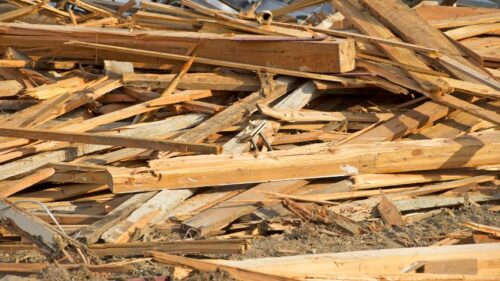
How to Dispose of Wood Waste?
What Are the Different Grades of Recycled Wood?
When it comes to disposing of wood waste, understanding the different grades of recycled wood is crucial. Let’s break it down:
Grade A: This recycled wood is made from pallets and is perfect for mulch and bedding. Because it hasn’t been combined with any other substances or pollutants, it is regarded as clean. Therefore, Grade A reclaimed wood is the way to go if you want to build a comfy bed for your plants or improve your garden with nutrient-rich mulch.
Grade B: This is what we refer to as industrial-grade feedstock; it is made up of construction waste and Grade A wood. Panel boarding serves as the purpose for this particular grade. Therefore, using Grade B recycled wood can be a budget-friendly and environmentally-friendly choice if you’re planning any DIY projects that need for robust boards or panels.

Grade C: In search of biomass fuel? Recycled wood grade C will take care of you. It may include both Grade A and B woods, as well as collections from local governments. Utilizing this grade as biomass fuel reduces dependency on fossil fuels while minimizing waste for everything from heating systems to electricity generation.
Grade D: With Grade D recycled wood, things become a little more difficult. It includes all varieties of wood, including untreated, painted, trackwork, and fencing. This kind of garbage needs to be disposed of in specialized facilities meant for handling hazardous waste because of its potentially harmful nature (think of the chemicals used in treatments).
How to Dispose of Wood Waste?
Disposing at a wood processing facility
Businesses wishing to lessen their environmental effect can consider disposing of their wood waste at a wood processing company. There is frequently a sizable amount of solid trash produced during building construction or demolition, especially wood products. Businesses can decide to dispose of this trash at a wood processing facility rather of putting it in landfills, where it will take up space and cause pollution.
Reuse Wood
Reusing the wood should be one of the options taken into consideration while disposing of wood waste. You can reuse the timber rather than dispose of it in a landfill where it will take up valuable space. For instance, contributing wood to a high school wood shop can help students learn how to use recycled resources and produce beautiful things.
Repairing and reusing pallets and wooden transport boxes is another technique to utilize wood. These tough containers are frequently easily repairable and can be reused for storage or transit. You are minimizing trash and giving these things a second chance by reusing them.
Don’t just dump the deteriorated wood in the trash when it comes to ancient fences that need to be taken down! It is possible to use this gorgeously aged material again for landscaping tasks. Reusing old fence planks gives your outdoor space individuality and sustainability, whether as plant borders or decorative accents.

Additionally, treated woods are perfect for reuse in building projects, including utility poles and railroad ties. They can be employed in the construction of fences, barriers in parking lots, and even in the management of erosion along riverbanks. It’s crucial to remember that some treatments, such as chromate copper arsenate (CCA), can contaminate soil and water if not used appropriately.
It’s critical from a public health perspective not to reuse lead-painted wood without taking the necessary safeguards, despite the aesthetic allure of the material. There are significant dangers associated with lead exposure, particularly when dust or paint chips are handled or disposed of in a way that causes them to become airborne.
Recycling
Recycling is a fantastic solution for getting rid of wood waste. You may transform wood that cannot be used in its natural state into a variety of valuable goods rather than just throwing it away. Compost for soil improvement is an example of such a product. You may produce nutrient-rich soil amendments that conserve water and stop soil erosion by composting wood debris.
Dangers of improper wood recycling
Reusing wood for various purposes, including building fences, patio furniture, and landscaping, is a widespread activity. It’s crucial to be aware of any risks connected to incorrect wood waste recycling. The majority of the wood used for these projects has undergone chemical treatment to guard against fungus, insects, and weather damage. Although this treatment considerably increases the wood’s lifespan, it also poses threats to the environment and to human health.

There are three main types of wood preservatives commonly used: oil-based preservatives like Penta, creosote made from coal tar distilled chemicals in coking ovens, and waterborne ones typically containing chromate copper arsenate. Unfortunately, these treatments have been linked to serious health issues, including fetal damage, birth defects, and other health problems.
Moreover, improper disposal of treated wood can lead to environmental hazards. The fumes from creosote-treated wood pose risks not only to human health but also contribute to pollution in our surroundings. Waterborne preservatives may be toxic under certain conditions according to EPA classification.
These are a few ways to get rid of your wood waste. You should follow any of these methods to protect our environment.